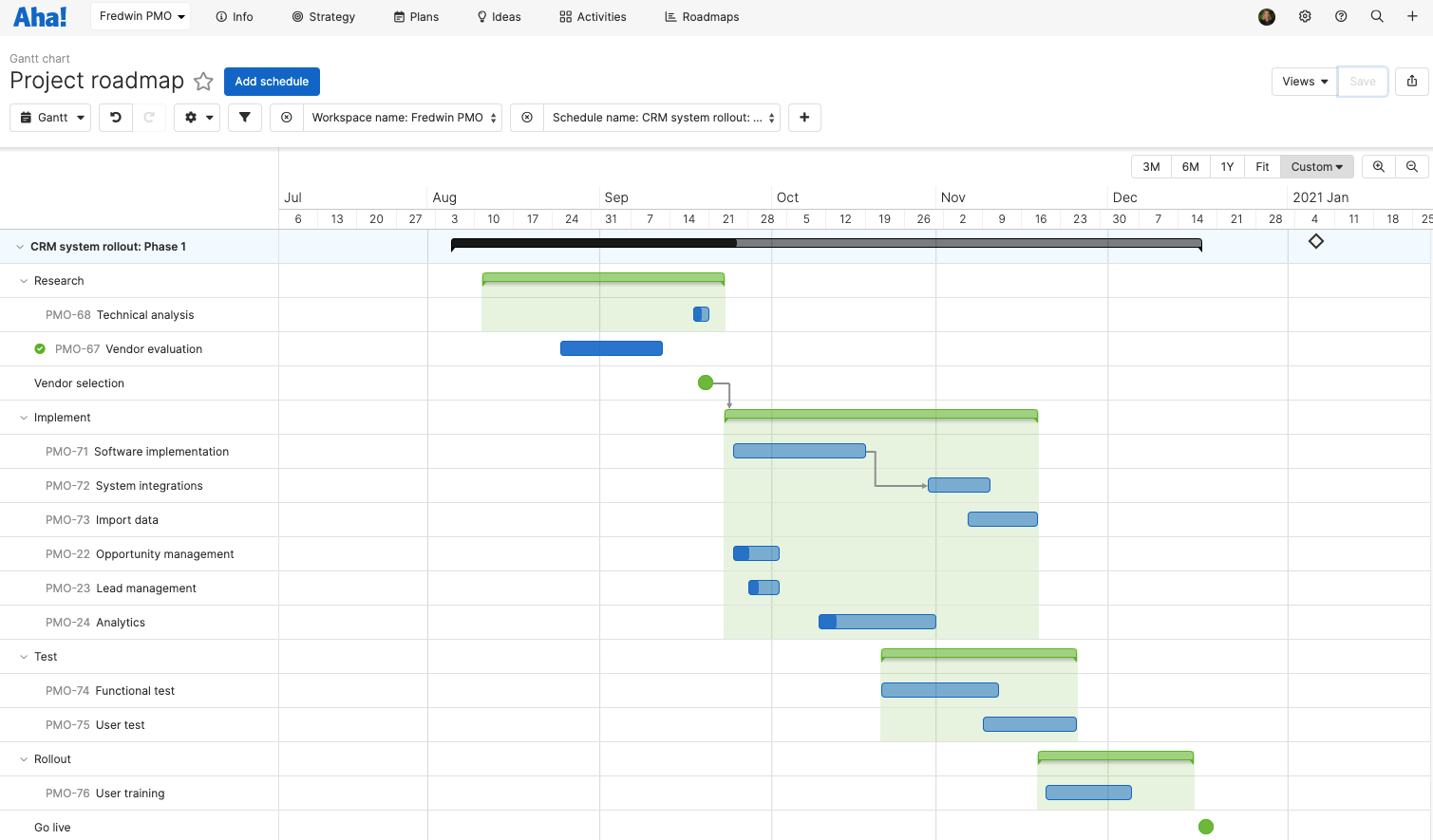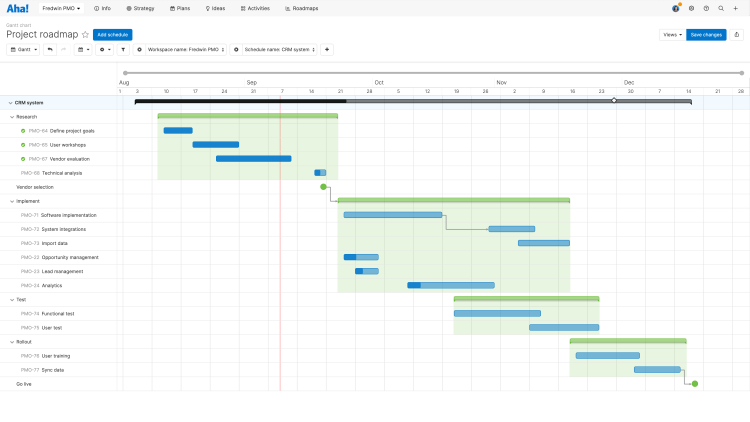What is a project roadmap? Best practices for project managers
A project roadmap is a visual timeline of all project objectives, tasks, and responsibilities. It is often aligned with your product lifecycle (e.g., initiation, planning, execution, and closure) and includes fixed start and end dates. Use a project roadmap to help make prioritization decisions, communicate required actions, and track progress against goals.
The details on your roadmap can be high-level or more granular — depending on who you are presenting it to and what you need to communicate. For instance, executives probably do not need to see every single project task. But cross-functional teammates will want to know exactly what they need to contribute and when.
Build your own roadmap in Aha! Roadmaps. Sign up for free trial.

This Gantt chart-style project roadmap was created in Aha! Roadmaps.
Project roadmaps typically include the following components:
Project goals or objectives
Resource allocation and budget
Important milestones and high-level deadlines
Tasks for multiple people or cross-functional teams
Partner, stakeholder, or cross-functional responsibilities
It takes time to perfect your roadmap and determine the right level of detail to include. Understand that roadmaps are collaborative and dynamic. You will revisit and update your roadmap as your project comes to life and as you receive feedback from stakeholders.
Jump ahead to any section:
What kinds of projects need a roadmap?
Any project or program with strategic goals, a budget and timeline, and multiple stakeholders can benefit from a roadmap. For example, a project manager at a manufacturing facility can use a roadmap to manage production lines or new equipment. A business analyst can use a roadmap to visualize the implementation of a new business intelligence tool. An event manager can use a roadmap to visualize event strategy and plans for the upcoming year. Of course, the focus for each roadmap will depend on the specifics of what you are managing.
Clearly defining the project's scope, success criteria, requirements, and internal and external stakeholders is essential to building the right roadmap for your project. When you know where you are headed, who you are serving, and why it matters, you can successfully craft a roadmap that is both delightful and actionable.
Why are project roadmaps important?
The power of a roadmap is the connection between objectives and outcomes. Anyone who views the roadmap should be able to quickly understand the goals of your project and what you are planning to achieve. Your project roadmap helps you gain the following:
Accountability | Use your project roadmap to show what each team will deliver and when. Track progress, ensure that deadlines are met, and keep everyone accountable to their work. |
Alignment and prioritization | Connect project goals to the activities and tasks on your roadmap so everyone understands their part in the success of the project. Priorities may shift — use the roadmap to guide prioritization decisions and ensure that what you are working towards connects back to your goals. |
Communication | Keep teammates in sync and update key stakeholders on project progress. Roadmaps can be used to communicate plans throughout each phase of a project's lifecycle, from initiating to closing it. |
Coordination | Your project roadmap gives everyone a view of deliverables and timing so you can coordinate shared work, dependencies, and hand-offs. |
Visibility | Create customized roadmap views for various stakeholders to give everyone a view of their role in the project. This gives folks the opportunity to ask questions, sharpen expectations, and quickly spot problems related to scope or limited resources. |
Project roadmap vs. project plan vs. project charter
Project roadmaps, plans, and charters — do project managers need all three? The answer is likely yes, given the differences and purposes of these documents:
Project charter | A project charter is a document that summarizes project objectives and scope. Think of it like a business case for the project — with high-level goals, major areas of focus, success metrics, and the budget. A charter is typically used to get stakeholder buy-in when initiating a new project. |
Project plan | A project plan guides the project team towards the specific details of how you will achieve the project objectives. It can include project requirements, tasks, deadlines, roles, responsibilities, and resources. |
Project roadmap | The project roadmap is the visualization of your project plans. It lays out the goals, the work you will do, and when you will deliver it. |
Your organization might use other terms for these same concepts. For example, a project charter can also be referred to as a project definition, a project statement, or a project brief. The names of the documents may vary, but their purposes are similar. Every successful project requires you to outline the objectives, activities, and deadlines required to move the project forward.
Project roadmap vs. Gantt chart
Most project managers are familiar with Gantt charts — another type of visual plan that displays the project schedule. While a project roadmap typically shows the general start and end dates for given phases or activities, Gantt charts go deeper. They include the nitty gritty details about tasks, assignees, and due dates.
Think of your project roadmap as a visualization of your high-level plans and the Gantt chart as the visualization of the specific details that need to be delivered. If you build roadmaps in a purpose-built tool like Aha! Roadmaps, a summary-level roadmap and a Gantt-style view can be created from the same inputs. You can enter project plans once and drill into the level of detail you need to view.
Project roadmap examples
Project managers need to share project details quite often — both at the start of a project and to convey progress and revisions along the way. You have worked hard on your project plans, so choose a roadmap type that will engage the audience you are presenting to.
Depending on your situation, consider the following types of roadmaps:
Project initiatives roadmap
If your organization has a project management team, you may have initiatives or improvements that you are focused on together — such as process efficiencies or cost-savings efforts across projects. Build a project initiatives roadmap to capture goals, initiatives, and an overall timeline for your top-priority work as a project management office (PMO) or department.

This is a custom project roadmap with goals and strategic initiatives.
Activities roadmap
When you need to showcase specific details of individual projects, use an activities roadmap. This version of a roadmap shows projects in swim lanes with activities and individual work items under each. An activities roadmap is useful when you want to highlight upcoming deliverables or make trade-off decisions about where to prioritize your time.

This is an example of an activities project roadmap.
Gantt chart-style roadmap
A Gantt chart-style roadmap is ideal for planning work across teams or functions. You can use this style of roadmap to track phases, deadlines, dependencies, and milestones. This roadmap view should still be connected to the project's objectives in order to communicate the "why" behind the detailed work.

This is a Gantt chart-style project roadmap with project phases.
How to build a project roadmap
You first need to complete the project planning phase before you build your roadmap. Be sure that you understand the goals of your project and have determined its criteria for success. While you probably do not need to outline the full project schedule upfront, you do need to know the project scope, what needs to be completed to achieve project goals, and general start and end dates. With a clear understanding of the "why," "what," and "when," you can begin to plot it all on a roadmap.
Some project managers create roadmap views in spreadsheets or presentation tools. Templates in Excel and PowerPoint can be useful starting points to visualize early plans. But once you get into the details of the work, static documentation is hard to format and keep updated in real time. Project management software and purpose-built roadmapping tools like Aha! Roadmaps give you a single source of truth. You can enter project details once and then tailor roadmap views to your audience.
Look for a tool that allows you to display and customize the following elements:
Project start and end dates on a timeline view
Goals and success metrics
Initiatives, activities, and major themes of work
Project phases, milestones, and dependencies
Detailed tasks, including assignees and due dates
Internal and external deadlines
Of course, a project manager's work does not end with planning or building a roadmap. Now you have the responsibility to oversee your project through to completion. This is where a tool like Aha! Roadmaps brings continued value. You can assign and manage all the work in one place. And as you communicate and collaborate on the work items, your plans and project roadmap automatically adjust.
Complete successful projects on schedule with Aha! Roadmaps — sign up for a free 30-day trial.